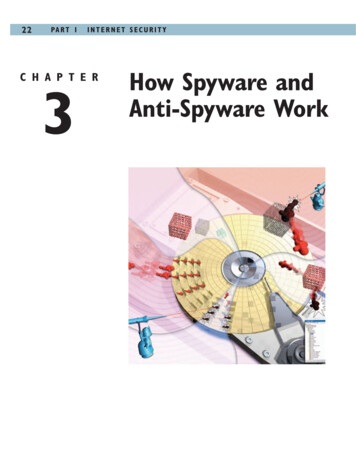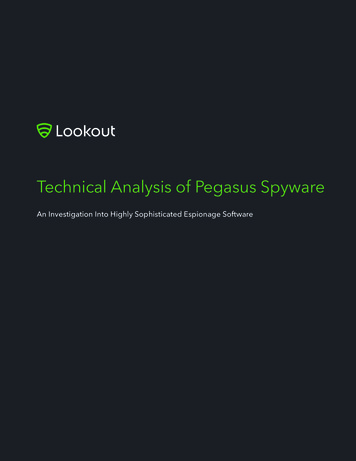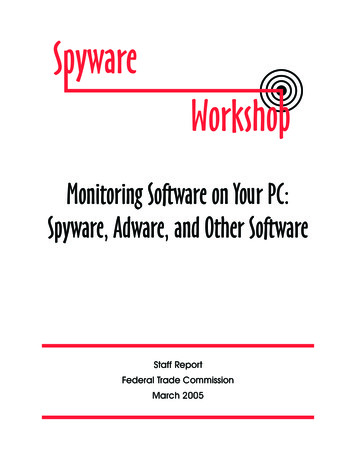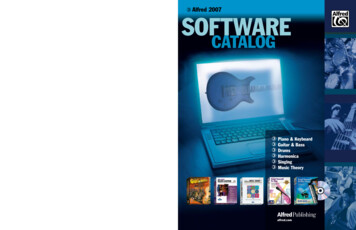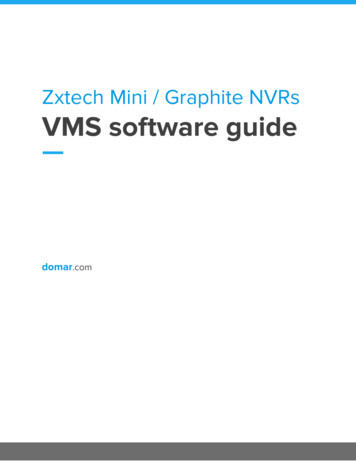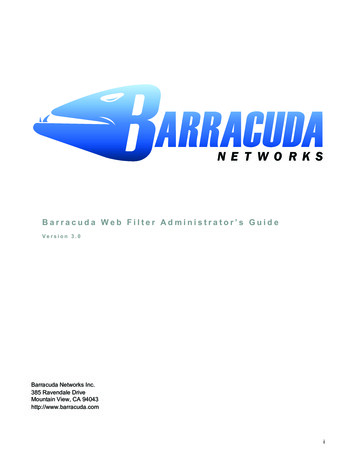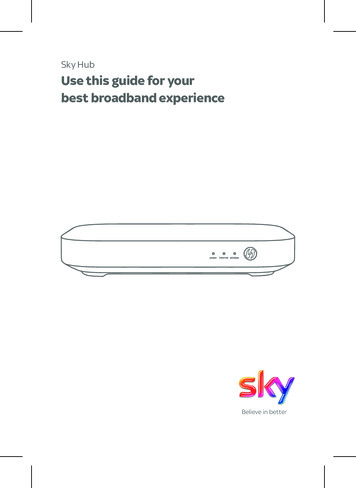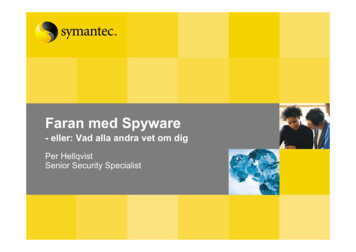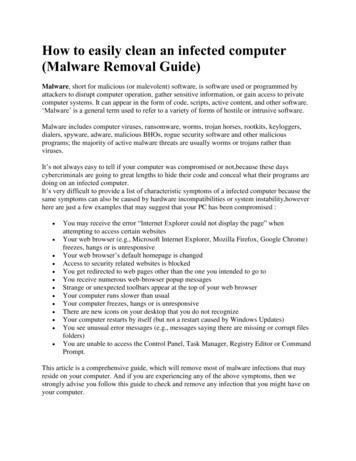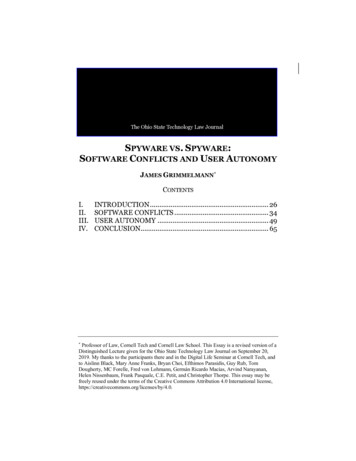
Transcription
The Ohio State Technology Law JournalSPYWARE VS. SPYWARE:SOFTWARE CONFLICTS AND USER AUTONOMYJAMES GRIMMELMANN*CONTENTSI.II.III.IV.*INTRODUCTION . 26SOFTWARE CONFLICTS . 34USER AUTONOMY . 49CONCLUSION. 65Professor of Law, Cornell Tech and Cornell Law School. This Essay is a revised version of aDistinguished Lecture given for the Ohio State Technology Law Journal on September 20,2019. My thanks to the participants there and in the Digital Life Seminar at Cornell Tech, andto Aislinn Black, Mary Anne Franks, Bryan Choi, Efthimos Parasidis, Guy Rub, TomDougherty, MC Forelle, Fred von Lohmann, Germán Ricardo Macías, Arvind Narayanan,Helen Nissenbaum, Frank Pasquale, C.E. Petit, and Christopher Thorpe. This essay may befreely reused under the terms of the Creative Commons Attribution 4.0 International 0.
26I.THE OHIO STATE TECHNOLOGY LAW JOURNAL[Vol. 16.1IntroductionThis is the story of the time that Apple broke Zoom, and everybodywas surprisingly okay with it. The short version is that Zoom providesone of the most widely used video-conferencing systems in the world.One reason for Zoom’s popularity is its ease of use; one reason Zoomwas easy to use was that it had a feature that let users join calls with asingle click. On macOS, Zoom implemented this feature by running acustom web server on users’ computers; the server would receiveZoom-specific requests and respond by launching Zoom andconnecting to the call.1 Security researchers realized that that webpages could use this feature to join users to Zoom calls without anyfurther confirmation on their part, potentially enabling surveillancethrough their webcams and microphones.2 The researchers released aproof-of-concept exploit in the form of a webpage that wouldimmediately connect anyone who visited it to a Zoom video call withrandom strangers.3 They also sketched out ways in which the Zoomserver on users’ computers could potentially be used to hijack thosecomputers into running arbitrary code.4After the story came to light, Apple’s response was swift andunsparing. It pushed out a software update to macOS to delete the1Jonathan Leitschuh, Zoom Zero Day: 4 Million Webcams & Maybe an RCE? Just GetThem to Visit Your Website!, MEDIUM (July 8, to-visit-your-website-ac75c83f4ef5 [https://perma.cc/7W3Y-LDHY]. Using acustom local web server bypassed security checks ordinarily performed by browsers. Id. Seegenerally Dan Goodin, Zoom for Mac Made It Too Easy for Hackers to Access Webcams.Here’s What to Do [Updated], ARS TECHNICA (July 9, 2019, 6:33 ss-webcams-heres-what-to-do/.2Leitschuh, supra note 1.3Id.; see also Matt Haughey (@mathowie), TWITTER (July 8, 2019, 8:39 824921600 [https://perma.cc/FP4F-EC27](“This Zoom vulnerability is bananas. I tried one of the proof of concept links and gotconnected to three other randos also freaking out about it in real time.”).4Assetnote Team, Zoom Zero Day Followup: Getting the RCE, ASSETNOTE (July 17, /17/rce-on-zoom/ [https://perma.cc/M528-7PX9];Leitschuh, supra note 1.
2020]GRIMMELMANN27Zoom server and prevent it from being reinstalled.5 The update wasremarkable, and not just because it removed functionality rather thanadding it. Typical Apple updates to macOS show a pop-up notificationthat lets users choose whether and when to install an update. ButApple pushed out this update silently and automatically; users woke upto discover that the update had already been installed—if theydiscovered it at all. In other words, Apple deliberately broke anapplication feature on millions of users’ computers without notice orspecific consent. And then, six days later, Apple did it again.6There is a lot that could be said about this episode; it illuminateseverything from responsible disclosure practices7 to corporate publicrelations to secure interface design for omnipresent cameras andmicrophones.8 But I want to dwell on just how strange it is that onemajor technology company (AAPL, market capitalization 1.4trillion9) deliberately broke a feature in another major technologycompany’s (ZM, market capitalization 24 billion10) product formillions of users, and almost no one even blinked. We are living in a5Dan Goodin, Silent Mac Update Nukes Dangerous Webserver Installed by Zoom, ARSTECHNICA (July 10, 2019, 7:50 PM), stalled-by-zoom/[https://perma.cc/G2SV-P5DC]; Zack Whittaker, Apple Has Pushed a Silent Mac Update toRemove Hidden Zoom Web Server, TECHCRUNCH (July 10, 2019, 6:06 -update-zoom-app/ [https://perma.cc/UD5J8GEB].6Dieter Bohn, Apple Is Silently Updating Macs Again to Remove Insecure Software FromZoom’s Partners, VERGE (July 16, 2019, 1:20 abilty-patched [https://perma.cc/RS87-S6C8].7See ALANA MAURUSHAT, DISCLOSURE OF SECURITY VULNERABILITIES: LEGAL AND ETHICALISSUES (2013); Kristin M. Bergman, A Target to the Heart of the First Amendment:Government Endorsement of Responsible Disclosure as Unconstitutional, 13 NW. J. TECH. &INTELL. PROP. 117 (2015).8See, e.g., Matthew Brocker & Stephen Checkoway, iSeeYou: Disabling the MacBookWebcam Indicator LED (Dec. 12, 2013) (unpublished andle/1774.2/36569 (demonstrating an attack to foil asecurity feature in which an indicator light was lit whenever a Mac’s webcam was turned on).9As of February 11, 2020. Apple Market Cap, YCHARTS,https://ycharts.com/companies/AAPL/market cap (last visited Feb. 20, 2020).10As of February 11, 2020. Zoom Video Communications Market Cap, YCHARTS,https://ycharts.com/companies/ZM/market cap (last visited Feb. 20, 2020).
28THE OHIO STATE TECHNOLOGY LAW JOURNAL[Vol. 16.1William Gibson future of megacorporations waging digital warfare oneach other’s software and everyone just accepts that this is how life isnow.Lest you think I am dwelling on an isolated and unrepresentativeincident, here are some further examples of programs doing drive-byson each other like warring street gangs: Malware: Antivirus software attempts to prevent malwarefrom being installed on users’ computers, and to removethat software if found. Malware tries to install itself andevade detection and removal, so of course its first order ofbusiness is often to turn off any antivirus protection.11 video game bots: Some online game players use bots toplay the game for them, leveling up their characters andobtaining resources.12 Blizzard, which operates the populargame World of Warcraft (WoW), added a program calledWarden to WoW, which detects bots and reports them toBlizzard so it can ban their users from connecting toBlizzard’s servers.13 One bot maker, MDY, modified itscode to evade detection by Warden.14 Others developedtechniques to modify Warden itself and disable itssurveillance without alerting Blizzard.1511See, e.g., DoubleAgent: Taking Full Control Over Your Antivirus, CYBELLUM (Mar. 22,2017), ol-antivirus/[https://perma.cc/2BMR-VEY5]; Malware Uses Certificates to Disable the Installation ofAnti-Malware Solutions on Your Computer, upport/answer/1921/ [https://perma.cc/6N27-E8QK].12See, e.g., GREG HOGLUND & GARY MCGRAW, EXPLOITING ONLINE GAMES: CHEATINGMASSIVELY DISTRIBUTED SYSTEMS 19 (2007).13See, e.g., Andy Chalk, World of Warcraft Bot Factory Gives Up After Massive BlizzardBanhammering, PC GAMER (May 15, 2015), ry-gives-up-after-massive-blizzard-banhammering/ [https://perma.cc/V5RV-H7J4].14MDY Indus. v. Blizzard Entm’t, 629 F.3d 928, 936 (9th Cir. 2010).15Deceiving Blizzard Warden, HACKMAG, d-warden/ [https://perma.cc/MTA7-K3TS].
2020]GRIMMELMANN29 Ad blocking: Some websites show ads.16 In response, someusers install adblockers in their browsers to block the adson websites they visit. In reply, some websites detect whenads are being blocked and refuse to display content unlessthe adblockers are disabled. In surreply, some adblockersdisguise from websites the fact that their ads are beingblocked. Or, in reply, some websites modify their ads sothat adblockers cannot detect them, and in surreplyadblockers use more sophisticated techniques to recognizethe mutated ads. In the words of Parker Higgins, it is“[i]ncreasingly obvious that any debate about adblockers isa thin veneer over questions of basic control ofcomputers.”17 Ad injection: Or, maybe it is a browser plugin that showsthe ads and the website that objects. Today the preferredterm is “ad injectors”—defined as software “that modifies apage's content to insert or replace advertisements,irrespective of user consent”18—although readers of acertain age may remember the litigation over “popupads.”19 Browser vendors have adopted increasinglystringent rules to restrict ad injectors.20 Browser tracking: Websites use browser APIs, includingplacing cookies on users’ computers, to gather information16See generally Russell A. Miller, Liberation, Not Extortion: The Fate of Ad-Blocking inGerman and American Law (Aug. 15, 2017) (unpublished m?abstract id 3019254; Grant Storey et al., The Futureof Ad Blocking: An Analytical Framework and New Techniques (May 24, 2017) (unpublishedmanuscript), https://arxiv.org/pdf/1705.08568.pdf.17Parker Higgins (@xor), TWITTER (Sept. 7, 2015, 5:06 632 [https://perma.cc/9FG2-AEBY].18Kurt Thomas et al., Ad Injection at Scale: Assessing Deceptive AdvertisementModifications, in PROC. 2015 IEEE SYMPOSIUM ON SECURITY AND PRIVACY 151, 152 (2015).19E.g., 1-800-Contacts, Inc. v. WhenU.com, Inc, 414 F.3d 400 (2d Cir. 2005). For a moremodern example, see Halperin v. Int’l Web. Serv., LLC, 70 F. Supp. 3d 893 (N.D. Ill. 2014).20Nav Jagpal, Out with Unwanted Ad Injectors, GOOGLE SECURITY BLOG (Mar. 31, DR9-PWS5].
30THE OHIO STATE TECHNOLOGY LAW JOURNAL[Vol. 16.1about users and track them from page to page and site tosite. In response, browsers allow users to block or deletecookies to prevent websites from recognizing them. Inreply, websites have deployed ever more sophisticatedtechniques to fingerprint users’ browsers based on otherfeatures, such as which fonts they have installed21 and thecharacteristics of their computer’s battery.22 Also in reply,websites have deployed software techniques to circumventbrowser-based cookie blocking, for example by simulatinguser input so that browsers think that users had consciouslyinteracted with websites.23 In surreply, browser makershave removed or restricted the APIs enabling these formsof tracking, and take increasingly strong measures againstwebsites they identify as circumventing users’ cookiesettings.24 Email tracking: Emails can include HTML that refers toresources on the web, which has been used for years byemail senders to see who has opened an email—byincluding an image with a URL unique to a particular21E.g., Gunes Acar et al., FPDetective: Dusting the Web for Fingerprinters, in CCS ‘13:PROC. 2013 ACM SIGSAC CONF. ON COMP. & COMM. SECURITY 1129, 1130 674; Peter Eckersley, How Unique Is Your WebBrowser?, in PRIVACY ENHANCING TECHNOLOGIES 1, 4 (Mikhail Atallah & Nicholas Hoppereds., 2011).22Łukasz Olejnik et. al., The Leaking Battery: A Privacy Analysis of the HTML5 BatteryStatus API, in DATA PRIVACY MANAGEMENT, AND SECURITY ASSURANCE 254, 254 (JoaquinGarcia-Alfaro et al. eds., 2016).23See In re Google Inc. Cookie Placement Consumer Privacy Litigation, 806 F.3d 125, 131-32(3rd Cir. 2015); Jonathan Mayer, Safari Trackers (Feb. 17, ers/.24E.g., Bill Buddington, Apple's New WebKit Policy Takes a Hard Line for User Privacy,ELECTRONIC FRONTIER FOUND.: DEEP LINKS (Aug. 20, tps://perma.cc/MPJ5-5VG6]; Marissa Wood, Today’s Firefox Blocks Third-Party TrackingCookies and Cryptomining by Default, MOZILLA: BLOG (Sept. 3, -cryptomining-by-default/ [https://perma.cc/TPT9-ABY3].
2020]GRIMMELMANN31user.25 If that URL is loaded, the user has opened the email.So, of course, some email readers include options not toload remote resources unless the user specifically asks to.26 Jailbreaking: Some operating systems make it difficult orimpossible to install software not approved by theoperating-system vendor.27 Unsurprisingly, at the morerestrictive end there is a market for programs that willallow the installation of other programs the operatingsystem vendor has attempted to prevent.28 Some of theseprograms are used by device owners who want to“jailbreak” their devices to add new programs;29 some areused by hackers to surveil users;30 some are used by lawenforcement to decrypt devices during investigations.31What happens when operating-system vendors discoverthat one of these programs is in use? They push out anupdate to the operating system to disable it.3225E.g., Mike Davidson, Superhuman Is Spying on You, MIKE INDUSTRIES (June 30, QBH-LRVQ].26John Gruber, Superhuman and Email Privacy, DARING FIREBALL (July 23, n and email privacy [https://perma.cc/UQY7LCQH].27See, e.g., Safely Open Apps on Your Mac, APPLE (Oct. 7, 2019),https://support.apple.com/en-us/HT202491 [https://perma.cc/B3DZ-EPQG].28E.g., Lily Hay Newman, Unfixable iOS Device Exploit Is the Latest Apple SecurityUpheaval, WIRED (Sept. 27, 2019, 3:18 PM), phone-ipad/ [https://perma.cc/6TNH-UDED].29See, e.g., PANGU, http://en.pangu.io.30See, e.g., Ian Beer, A Very Deep Dive into iOS Exploit Chains Found in the Wild, PROJECTZERO (Aug. 29, 2019), ery-deep-dive-intoios-exploit.html [https://perma.cc/9WY3-GL2G].31E.g., Andy Greenberg, Cellebrite Says It Can Unlock Any iPhone for Cops, WIRED (June14, 2019, 6:05 PM), 32E.g., Shaun Nichols, Breaking News: Apple Un-Breaks Break on Jailbreak Break, REGISTER(Aug. 26, 2019, 11:38 PM),https://www.theregister.co.uk/2019/08/26/apple fixes ios124 jailbreak/[https://perma.cc/TPP9-V9BN].
32THE OHIO STATE TECHNOLOGY LAW JOURNAL[Vol. 16.1 Browser certificates: These contain public keys used bybrowsers to verify the identities of websites—therebyensuring that users’ communications with those websitesare securely encrypted. ISPs in Kazakhstan required usersto download and install a government-issued certificate,potentially allowing the government to eavesdrop on theircommunications with major websites like Facebook andTwitter.33 In response, Mozilla, Apple, and Google disabledthat certificate in their browsers, no matter how it wasinstalled.34 DRM: In the antediluvian pre-streaming days of digitalmusic, many users would use “ripping” software to makeMP3 copies of their CDs on their computers. Sony/BMGshipped a number of CDs which installed their own digitalrights management (DRM) software on PCs in which theywere inserted.35 This software—XCP and MediaMax CD3—prevented common ripping software from reading ormaking copies of Sony/BMG CDs.36 It also modified users’computers in ways designed to make it harder to remove;XCP in particular took steps to conceal its presence onusers’ computers and created additional securityvulnerabilities that other attackers could use to install theirown software on users’ computers. Security researcherscompared this DRM software to “rootkits”: forms ofmalware that actively resist attempts to uninstall them by33See RAM SUNDARA RAMAN ET AL., KAZAKHSTAN’S HTTP INTERCEPTION (2019),https://censoredplanet.org/kazakhstan [https://perma.cc/72XV-7VAR].34Catalin Cimpanu, Apple, Google, and Mozilla Block Kazakhstan's HTTPS InterceptingCertificate, ZDNET (Aug. 21, 2019, 10:00 PM), te/; Sydney Li, Browsers Take aStand Against Kazakhstan’s Invasive Internet Surveillance, ELECTRONIC FRONTIER FOUND.:DEEP LINKS (Aug. 22, 2019), illance [https://perma.cc/5PKT-9R89].35See generally Deirdre K. Mulligan & Aaron K. Perzanowski, The Magnificence of theDisaster: Reconstructing the Sony/BMG Rootkit Incident, 22 BERK. TECH. L.J. 1157, 1158(2007).36Mark Russinovich, Sony, Rootkits and Digital Rights Management Gone Too Far, MARK’SBLOG (Oct. 31, 2005), ement-gone-too-far/ [https://perma.cc/9HLZ-8UX9].
2020]GRIMMELMANN33hiding, disabling removal programs, and reinstallingthemselves if partially removed.I could go on, but you get the picture.One way to make sense of these program-versus-program conflictswould be to proceed methodically through the bodies of law that couldbe (and have been) brought to bear on them. But their sheer number isstunning. There are statutory computer-misuse claims under theComputer Fraud and Abuse Act and its state analogs against programsthat access users’ computers without authorization.37 There areproperty-tort claims for trespass to chattels against programs that harmusers’ computers.38 There are contractual claims by users againstprograms that break their promises, and tortious interference claimsagainst programs that keep other programs from working aspromised.39 There are copyright claims for modifying programs andcontent in unapproved ways;40 there are trademark claims for passingoff modifications as the original, and for misrepresenting therelationship between a program and its victim.41 Section 1201 of theDigital Millennium Copyright Act42 prohibits circumventingtechnological protections on copyrighted works (including music onCDs and games like World of Warcraft),43 and section 1202,44 whichhas been interpreted to prohibit stripping certain kinds of metadatafrom copyrighted works,45 might also sometimes be in play. When aprogram justifies disabling another on the ground that it is harmful—asantivirus software does with malware—this justification may itselfsometimes be actionable as trade libel, or as defamation of its3718 U.S.C. § 1030 (2008).The leading case on online trespass to chattels, Intel Corp. v. Hamidi, 71 P.3d 296 (Cal.2003), held that the tort did not lie without “some actual injury,” but that requirement willtypically be satisfied when a defendant “impairs [the] functioning” of a program on theplaintiff’s computer. Id. at 300.39E.g., Zango, Inc. v. Kaspersky Lab, Inc., 568 F. 3d 1169, 1171-72 (9th Cir. 2019).40E.g., MDY Indus. v. Blizzard Entm’t, 629 F.3d 928, 937 (9th Cir. 2010).41E.g., U-Haul Intern. v. whenU.com, Inc., 279 F. Supp. 2d 723, 727-29 (E.D. Va. 2003).4217 U.S.C. § 1201 (1998).43MDY Indus., 629 F.3d at 943-52.4417 U.S.C. § 1202 (1999).45See e.g., Murphy v. Millennium Radio Grp., 650 F.3d 295, 305 (2011).38
34THE OHIO STATE TECHNOLOGY LAW JOURNAL[Vol. 16.1developers.46 If the makers of the two programs compete, actions byone against the other might violate the antitrust laws.47 Any of theabove in violation of a privacy policy, or terms of service, or otherrepresentation to users might be a deceptive trade practice in the viewof the Federal Trade Commission and state attorneys general.48 Cuttingacross almost all of the above there are some commonly arisingdefenses, such as Section 230(c)(2) of the Communications DecencyAct, which protects “any action voluntarily taken in good faith torestrict access to or availability” of “objectionable” material.49 And atthe Constitutional level, restrictions on software functionality can raiseFirst, Fifth, and Fourteenth Amendment issues.The length of this list should give pause. If there is a principled way toresolve these software-versus-software conflicts, it needs a firmerfoundation than a mess of doctrinal detail. If these bodies of law reachconsistent results, we should seek the common thread that explainsthem all. If they reach inconsistent results, we should seek a coherentbasis to harmonize them. Either way, we need a theory. So I wouldlike to come at the problem the other way around: what kinds ofprinciples might help sort out these cases?Part II of this essay describes three seemingly appealing heuristics forresolving software conflicts—banning bad software, promoting userfreedom, and enforcing contracts—each of which fails badly whenconfronted with common fact patterns. Part III argues that the missingelement is user autonomy: only by connecting software’s effects forusers with their choices of what software to run and what contracts toagree to is it possible to make sense of software conflicts.II.46Software ConflictsSee, e.g., NEW.NET v. Lavasoft, 356 F. Supp. 2d 1071, 1113 (C.D. Cal. 2003).See e.g., In re Apple iPod iTunes Antitrust Litigation, 796 F. Supp. 2d 1137, 1143 (N.D.Cal. 2011).4815 U.S.C. § 45 (2006).4947 U.S.C. § 230(c)(2) (1996).47
2020]GRIMMELMANN35Three theories of software conflicts are so straightforward, sowidespread, and so intuitively appealing that they are often simplyassumed. The first is that certain program behavior is intrinsicallyharmful and should be prohibited. Programs should not spy on usersand delete their files. Call this theory “Bad Software Is Bad.” Thesecond is that users should be allowed to run whatever software theywant. Call this theory “Software Freedom.” And the third is that bothusers and software vendors should be held to the terms of whatevercontracts they enter into. Call this “Click to Agree.” Each theorycaptures an important insight about software but is incomplete on itsown. Each theory gives good explanations in some easy cases butquickly runs into trouble in harder cases. Sometimes the theoriesagree, and sometimes they do not. We can understand much aboutsoftware conflicts by studying the cases where one theory fails andanother succeeds. We can understand even more by studying the caseswhere all three fall short.a. Bad Software Is BadThe first, and in some ways most intuitive, theory focuses on thetechnical characteristics of the software itself. Most programs areGood and do useful things for users. But some programs are Bad.Programs can be Bad because they harm users by invading theirprivacy and deleting their data, because they harm other people bypirating copyrighted works and making pornographic deepfakes, orbecause they harm other programs in all of the ways listed above. Thelegal system should intervene when Bad programs do Bad things,including when they disable Good programs. And, a little more subtly,the legal system should allow Good programs to disable Badprograms.The underlying intuition here is sound. Some programs really areobjectively Bad. Spousal spyware can put users in physical danger by
36THE OHIO STATE TECHNOLOGY LAW JOURNAL[Vol. 16.1enabling abusive partners to stalk them.50 Ransomware that encryptsusers’ files until they send Bitcoin in exchange for a decryption key isalso 100% downside: it does nothing good for its victims, ever.51Norton AntiVirus is Good;52 NotPetya is Bad.53 It makes perfect sensethat the former should be allowed to block the latter, just as BadSoftware Is Bad recommends. A theory that did the opposite and tookthe side of “the most devastating cyberattack in history” over antivirussoftware trying to stop it would be a non-starter.54These are easy cases because the costs and benefits are so lopsided:one of the two programs is all cost and no benefit. To be sure, in theblasted Fury Road hellscape that is Internet security, there is noshortage of obvious villains, and thus no shortage of easy cases. Butnot all cases are so easy.Compare a stereotypically Good program like Chrome RemoteDesktop55 with a stereotypically Bad program like FlawedAmmyy.56The former is thought of as a useful utility that lets systemadministrators upgrade employees’ computers and provide tech50E.g., Rahul Chatterjee et al., The Spyware Used in Intimate Partner Violence, in PROC. 2018IEEE SYMPOSIUM ON SECURITY AND PRIVACY 441, 441 ?tp &arnumber 8418618.51See generally MALWAREBYTES, CYBERCRIME TACTICS AND TECHNIQUES: RANSOMWARERETROSPECTIVE (2019), TNT-2019Ransomware August FINAL.pdf; GAVIN O’GORMAN & GEOFF MCDONALD, RANSOMWARE: AGROWING MENACE rprise/media/security df.52But see Iulia Ion et al., “.No One Can Hack My Mind”: Comparing Expert and NonExpert Security Practices, in SOUPS 2015: PROC. ELEVENTH SYMPOSIUM ON USABLE PRIVACYAND SECURITY 327, 330-31 nce/soups2015/soups15-paper-ion.pdf (reportingthat security experts are less likely to recommend anti-virus software than non-experts are).53See Andy Greenberg, The Untold Story of NotPetya, the Most Devastating Cyberattack inHistory, WIRED (Aug. 22, 2018, 5:00 AM), raine-russia-code-crashed-the-world/ [https://perma.cc/AF6Y-EZWE].54Id.55CHROME REMOTE DESKTOP, https://remotedesktop.google.com (last visited Jan. 20, 2020).56See Proofpoint Staff, Leaked Ammyy Admin Source Code Turned into Malware,PROOFPOINT: BLOG (Mar. 7, 2018), leakedammyy-admin-source-code-turned-malware [https://perma.cc/PQ66-G3U4].
2020]GRIMMELMANN37support; the latter is thought of as a malicious “remote access Trojan”used by hackers to steal data and spy on users. But they havesubstantially identical functionality: they let someone use a computerover the Internet as though they were sitting at the keyboard andlooking at its screen. The difference is that people we call heroes useGoogle Remote Desktop to do good and people we call villains useFlawedAmmyy to do evil.It is not that there is no difference between good and evil online. It isjust that the difference is not a purely technical one. Even in caseswhere the answer seems intuitively clear—surely Mozilla Firefox isGood and the Kazakhstani government’s surveillance scheme is Bad—the clarity comes not from the functional characteristics of thesoftware itself but from the context in which it is used. Firefox shipswith over 150 certificates,57 and it has a feature to install more.58 Thedetermination that the Kazakhstani government was up to no goodwith its ISP-supplied certificate rested on contextual knowledge abouthow it was likely to spy on users with the certificate, rather thananything inherent to the certificate itself.Like certificates, many programs are dual use: they have both lawfuland unlawful uses. Remote desktop tools themselves are a goodexample: they are used both by actual tech support and by tech-supportscammers.59 A program that deletes a remote desktop tool might bethwarting a crime, committing one, or both. Spyware often falls intothis dual-use grey area: it is marketed as being for families wanting to57See Mozilla Included CA Certificate List, MOZILLA WIKI,https://wiki.mozilla.org/CA/Included Certificates (last visited Jan. 20, 2020).58See Setting Up Certificate Authorities (CAs) in Firefox, MOZILLA c/86MU-AVB4].59See MICROSOFT, GLOBAL TECH SUPPORT SCAM RESEARCH 2, 4-5 earch-2018.pdf.
38THE OHIO STATE TECHNOLOGY LAW JOURNAL[Vol. 16.1keep in touch with each other, with a wink-wink nudge-nudgeunderstanding that some actual uses will be less benign.60Nor does it help to rely on institutional identity. Obscure lone wolvescan produce Good software—some of the Internet’s most essentialinfrastructure is written and maintained by individual volunteers.61 Onthe other hand, major corporations can produce Bad software. TheSony/BMG rootkit is a prime example of software from a Fortune 500company that intentionally introduced egregious security violations tousers’ computers. One of the world’s leading antivirus makers, theRussian cybersecurity company Kaspersky, has been accused of usingits antivirus software to exfiltrate classified documents from the U.S.government.62In some cases, “Good” and “Bad” are themselves contested. For manycopyright owners, it is obvious that DRM is Good and circumventiontools are Bad; many open-source advocates and copyright skepticswould say exactly the opposite. Some people think that it is fine toplay World of Warcraft with bots; others vehemently disagree.Advertisers and adblockers have conflicting views about the legalityand morality of viewing content
30 THE OHIO STATE TECHNOLOGY LAW JOURNAL [Vol. 16.1 about users and track them from page to page and site to site. In response, browsers allow users to block or delete
